Impact of SLR on Beach-Tourism Resort Revenue at Sahl Hasheesh and Makadi Bay, Red Sea, Egypt; A Hedonic Pricing Approach
Abstract
1. Introduction
2. Materials and Methods
2.1. Study Area
2.2. Hedonic Pricing Method
- Semi-log, ln (Y) = b1 X1 + b2 X2 + b3 X3 + b4 X4 + b5 X5 + b6 X6 ± C
- Double-log, ln (Y) = b1 ln (X1) + b2 ln(X2) + b3 ln(X3) + b4 ln (X4) + b5 (X5) + b6 ln(X6) ± C
- Custom-log, ln (Y) = b1 ln (X1) + b2 X2+ b3 ln(X3) + b4 ln (X4) + b5 (X5) + b6 X6 ± C
3. Results and Discussions
3.1. Future Beach Width
3.2. Econometric Results
4. Conclusions
Author Contributions
Funding
Acknowledgments
Conflicts of Interest
References
- Rochelle, T. The Economic Impact of Travel and Tourism. Annual Research. 2018. Available online: https://www.wttc.org/ (accessed on 4 December 2018).
- El Raey, M. Impact of Sea Level Rise on the Arab Region; Arab Academy of Science, Technology, and Maritime, University of Alexandria: Alexandria, Egypt, 2010. [Google Scholar]
- El-Gamily, H.I.; Nasr, S.; El-Raey, M. An assessment of natural and human-induced changes along Hurghada and Ras Abu Soma coastal area, Red Sea, Egypt. Int. J. Remote Sens. 2001, 22, 2999–3014. [Google Scholar] [CrossRef]
- Frihy, O.E.; Fanos, A.M.; Khafagy, A.A.; Abu Aesha, A. Human impacts on the coastal zone of Hurghada, northern Red Sea, Egypt. Geo-Marine Lett. 1996, 16, 324–329. [Google Scholar] [CrossRef]
- Hilmi, N.; Safa, A.; Reynaud, S.; Allemand, D. Coral Reefs and T ourism in Egypt’s Red Sea. Top. Middle East. Afr. Econ. 2012, 14, 416–434. [Google Scholar]
- Church, J.A.; Clark, P.U. Sea Level Change. In Climate Change 2013: The Physical Science Basis. Contribution of Working Group I to the Fifth Assessment Report of the Intergovernmental Panel on Climate Change; Stocker, T.F., Qin, D., Plattner, G.K., Tignor, M., Allen, S.K., Boschung, J., Midgley, P.M., Eds.; Cambridge University Press: Cambridge, UK; New York, NY, USA, 2013. [Google Scholar]
- Toimil, A.; Díaz-Simal, P.; Losada, I.J.; Camus, P. Estimating the risk of loss of beach recreation value under climate change. Tour. Manag. 2018, 68, 387–400. [Google Scholar] [CrossRef]
- Hinkel, J.; Nicholls, R.J.; Tol, R.S.; Wang, Z.B.; Hamilton, J.M.; Boot, G.; Vafeidis, A.T.; McFadden, L.; Ganopolski, A.; Klein, R.J. A global analysis of erosion of sandy beaches and sea-level rise: An application of DIVA. Glob. Planet. Chang. 2013, 111, 150–158. [Google Scholar] [CrossRef]
- Bruun, P. Sea-level rise as a cause of shore erosion. J. Waterw. Harb. Div. 1962, 88, 117–132. [Google Scholar]
- Udo, K.; Takeda, Y. Projections of Future Beach Loss in Japan Due to Sea-Level Rise and Uncertainties in Projected Beach Loss. Coast. Eng. J. 2017, 59, 1–16. [Google Scholar] [CrossRef]
- Ritphring, S.; Somphong, C.; Udo, K.; Kazama, S. Projections of Future Beach Loss due to Sea Level Rise for Sandy Beaches along Thailand’s Coastlines. J. Coast. Res. 2018, 85, 541–545. [Google Scholar] [CrossRef]
- Sharaan, M.; Udo, K. Projections of future beach loss along the mediterranean coastline of Egypt due to sea-level rise. Appl. Ocean Res. 2020, 94, 101972. [Google Scholar] [CrossRef]
- Sagoe-Addy, K.; Appeaning, A.K. Effect of predicted sea level rise on tourism facilities along Ghana’s Accra coast. J. Coast. Conserv. 2013, 17, 155–166. [Google Scholar] [CrossRef]
- Rosen, S. Hedonic Prices and Implicit Markets: Product Differentiation in Pure Competition. J. Polit. Econ. 1974, 82, 34–55. [Google Scholar] [CrossRef]
- Pearce, D.; Atkinson, G.; Mourato, S. Chapter 11: Willingness to Pay vs. Willingness to Accept. In Cost-Benefit Analysis and the Environment: Recent Developments; Organisation for Economic Co-Operation and Development: Paris, France, 2006; pp. 155–167. [Google Scholar]
- Bitan, M.; Zviely, D. Lost value assessment of bathing beaches due to sea level rise: A case study of the Mediterranean coast of Israel. J. Coast. Conserv. 2019, 23, 773–783. [Google Scholar] [CrossRef]
- Parsons, G.R.; Powell, M. Measuring the cost of beach retreat. Coast. Manag. 2001, 29, 91–103. [Google Scholar]
- Rigall-I-Torrent, R.; Fluvià, M.; Ballester, R.; Saló, A.; Ariza, E.; Espinet, J.M. The effects of beach characteristics and location with respect to hotel prices. Tour. Manag. 2011, 32, 1150–1158. [Google Scholar] [CrossRef]
- Fleischer, A. A room with a view-A valuation of the Mediterranean Sea view. Tour. Manag. 2012, 33, 598–602. [Google Scholar] [CrossRef]
- Alexandrakis, G.; Manasakis, C.; Kampanis, N.A. Valuating the effects of beach erosion to tourism revenue. A management perspective. Ocean Coast. Manag. 2015, 111, 1–11. [Google Scholar] [CrossRef]
- Thinh, N.A.; Thanh, N.N.; Tuyen, L.T.; Hens, L. Tourism and beach erosion: Valuing the damage of beach erosion for tourism in the Hoi An World Heritage site, Vietnam. Environ. Dev. Sustain. 2019, 21, 2113–2124. [Google Scholar] [CrossRef]
- Mendoza-González, G.; Martínez, M.L.; Guevara, R.; Pérez-Maqueo, Q.; Garza-Lagler, M.C.; Howard, A. Towards a sustainable sun, sea, and sand tourism: The value of ocean view and proximity to the coast. Sustainability 2018, 10, 1012. [Google Scholar] [CrossRef]
- EL-Asmar, H.M.; Ahmed, M.H.; El-kafrawy, S.B.; Oubid-Allah, A.H.; Mohamed, T.A.; Khaled, M.A. Monitoring and assessing the coastal ecosystem at Hurghada, Red Sea coast, Egypt. J. Environ. Earth Sci. 2015, 5, 144–160. [Google Scholar]
- Frihy, O.E.; Hassan, A.N.; El Sayed, W.R.; Iskander, M.M.; Sherif, M.Y. A review of methods for constructing coastal recreational facilities in Egypt (Red Sea). Ecol. Eng. 2006, 27, 1–12. [Google Scholar] [CrossRef]
- Frihy, O.E.; El Ganaini, M.A.; El Sayed, W.R.; Iskander, M.M. The role of fringing coral reef in beach protection of Hurghada, Gulf of Suez, Red Sea of Egypt. Ecol. Eng. 2004, 22, 17–25. [Google Scholar] [CrossRef]
- Dewidar, K. Changes in the Shoreline Position Caused by Natural Processes for Coastline of Marsa Alam –Hamata, Red Sea, Egypt. Int. J. Geosci. 2011, 2, 523–529. [Google Scholar] [CrossRef]
- Hereher, M.E. Assessment of Egypt’s Red Sea coastal sensitivity to climate change. Environ. Earth Sci. 2015, 74, 2831–2843. [Google Scholar] [CrossRef]
- Shanas, P.R.; Aboobacker, V.M.; Albarakati, A.M.; Zubier, K.M. Climate driven variability of wind-waves in the Red Sea. Ocean Model. 2017, 119, 105–117. [Google Scholar] [CrossRef]
- Hereher, M.E. Assessment of South Sinai Coastal Vulnerability to Climate Change. J. Coast. Res. 2015, 316, 1469–1477. [Google Scholar] [CrossRef]
- Abuodha, P.A.; Woodroffe, C.D. Assessing vulnerability to sea-level rise using a coastal sensitivity index: A case study from southeast Australia. J. Coast. Conserv. 2010, 14, 189–205. [Google Scholar] [CrossRef]
- Sharaan, M.; Udo, K. Projections of Proper Beach Nourishment Volume as an Adaptation to Beach Recession based SLR along the Nile Delta Coastline of Egypt. J. Coast. Res. 2020, 95, 637–642. [Google Scholar] [CrossRef]
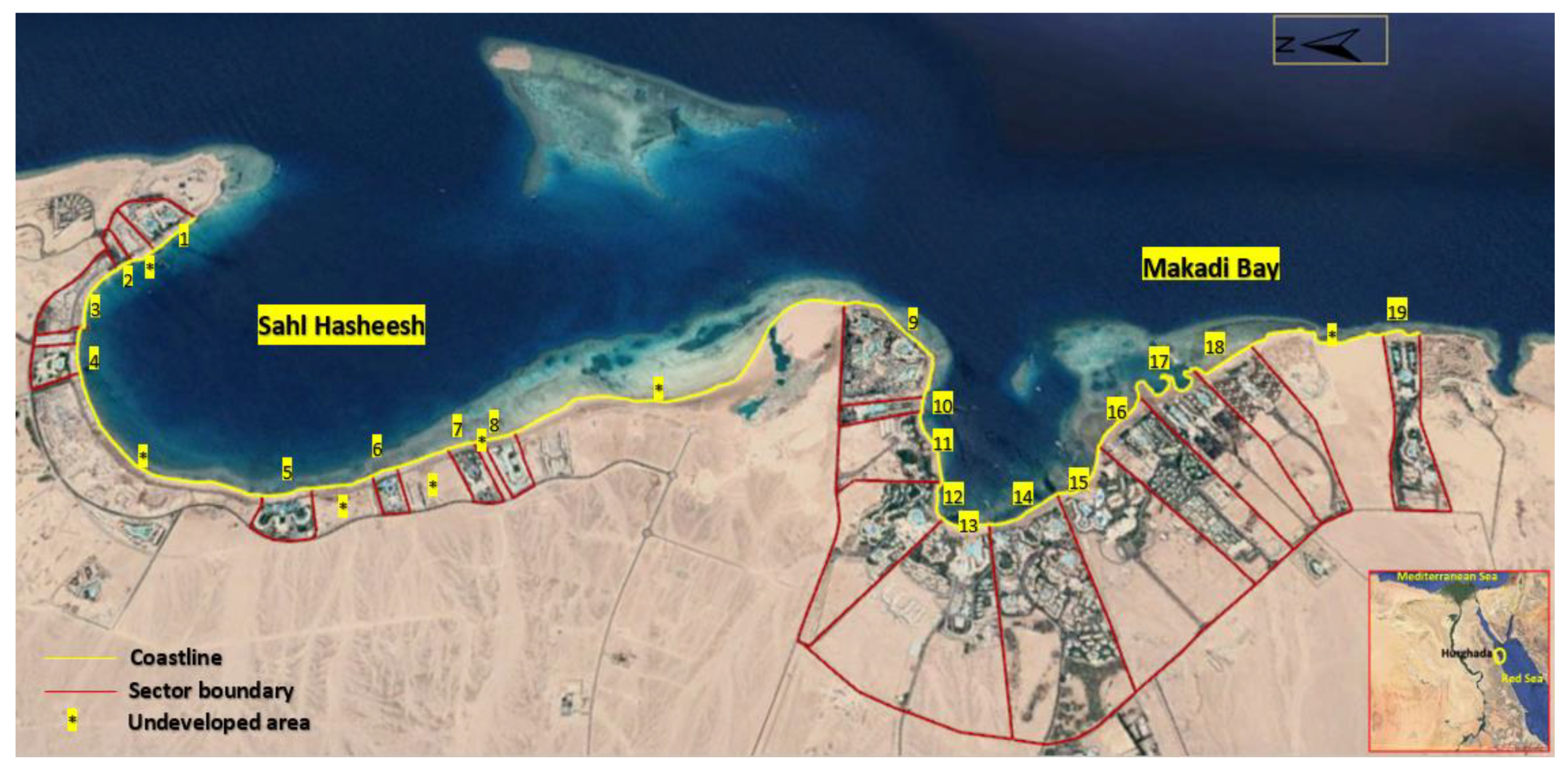
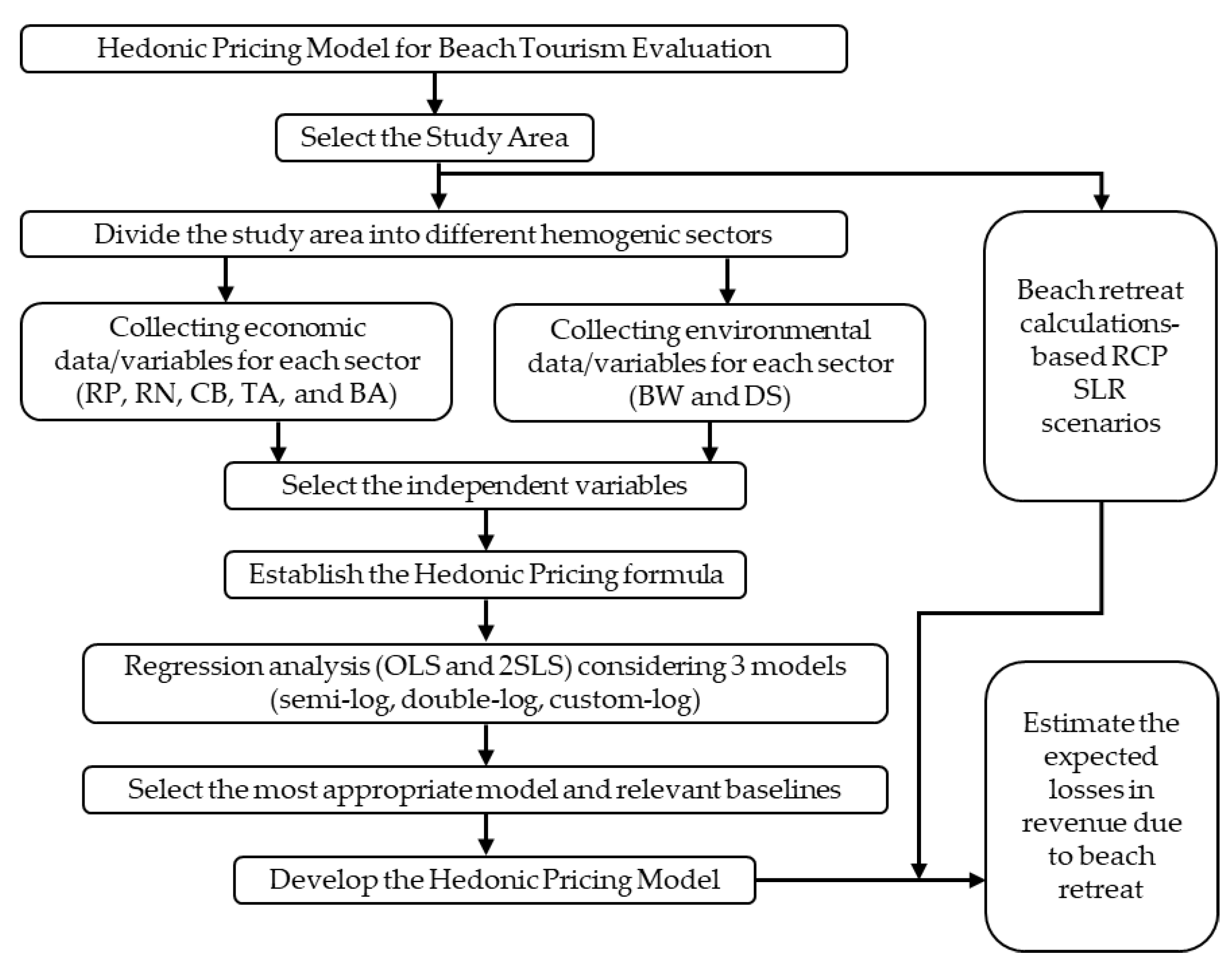
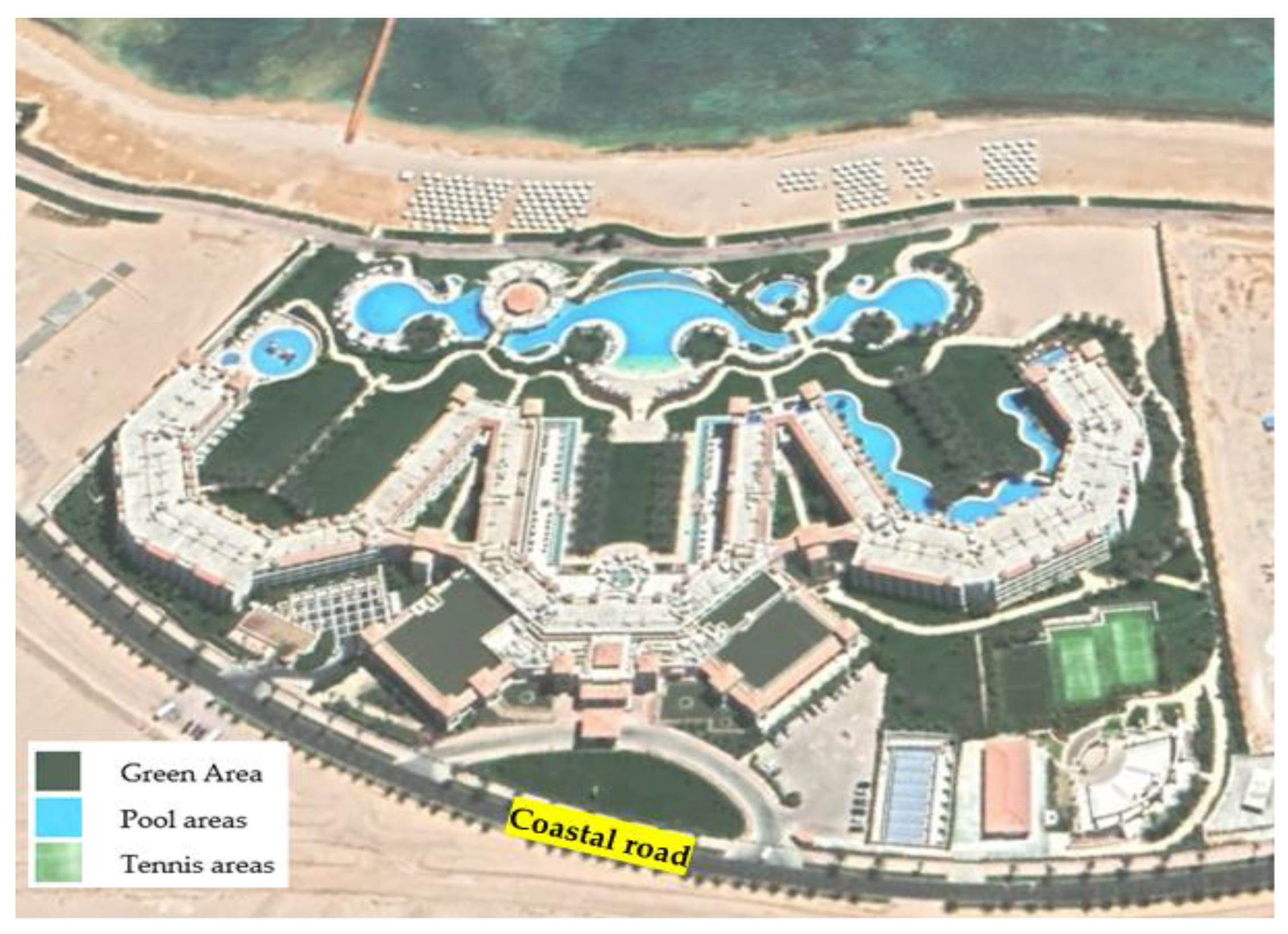
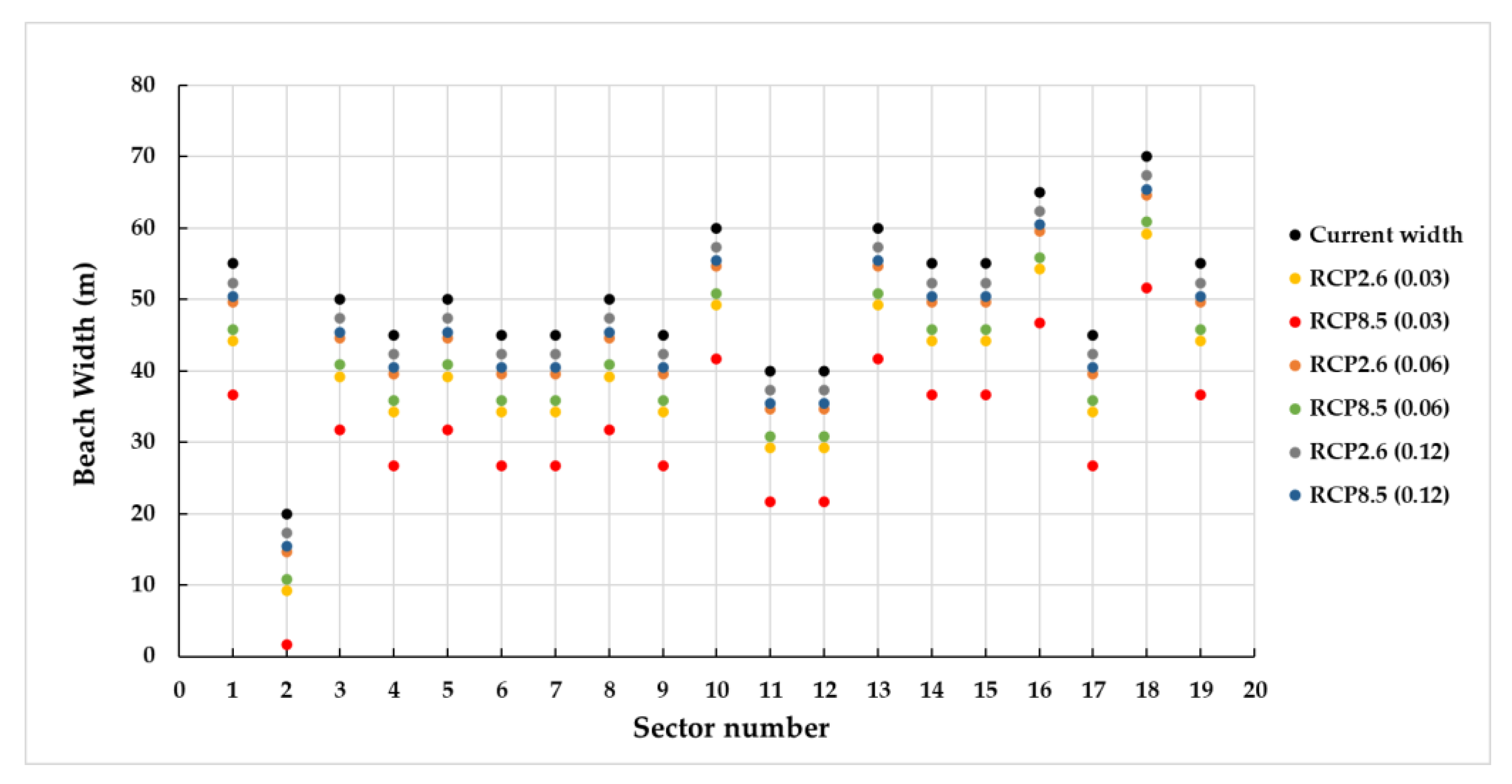
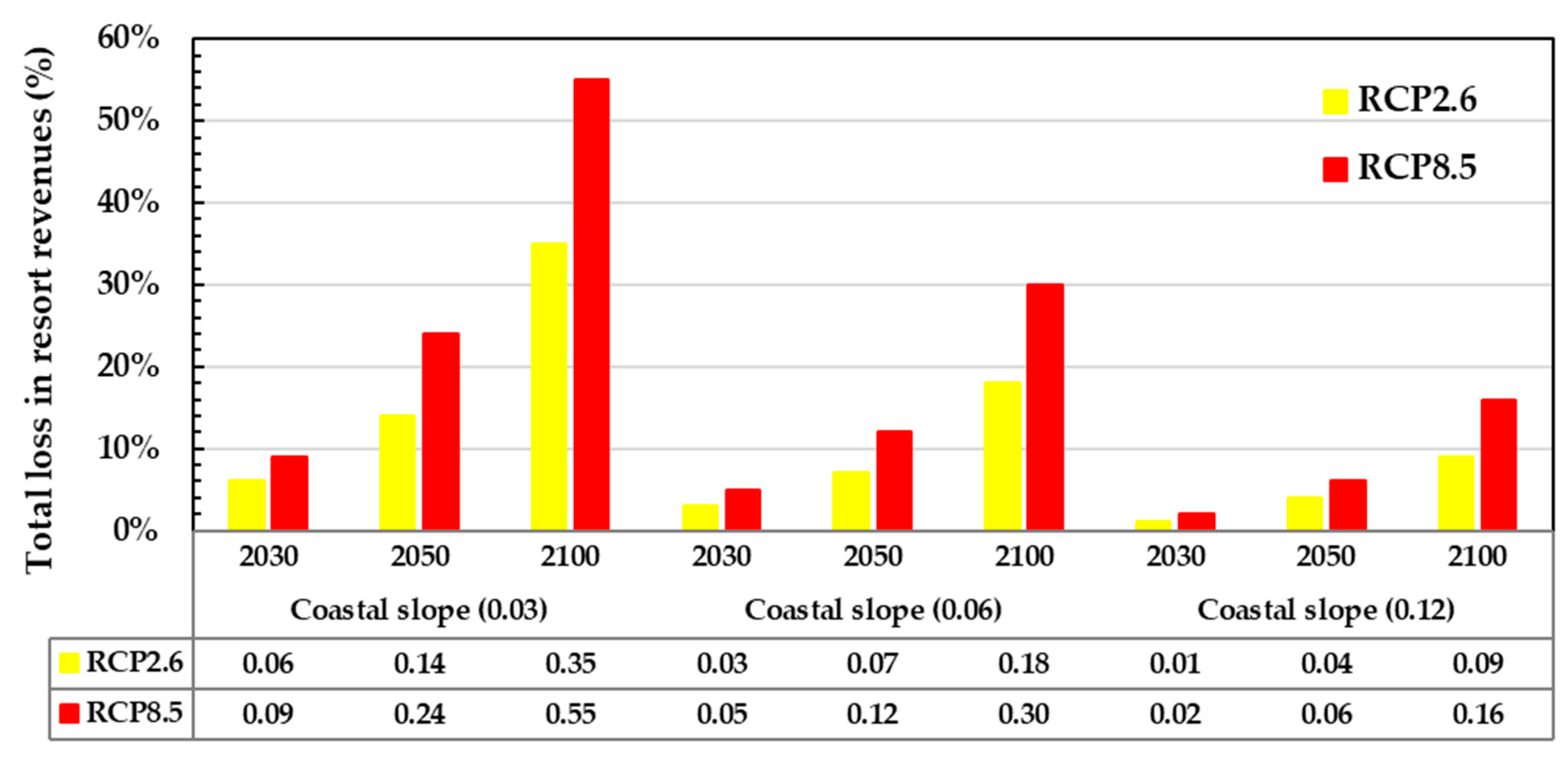
| Variables | Description | Statistics | ||||
|---|---|---|---|---|---|---|
| Mean | St. d | Min | Max | |||
| Room Price (USD/15 Days/Double Room) | RP | Average Price of Double Rooms for 15 Days in High Season (June to August 2019), Reserved Early | 1989 | 808 | 600 | 3750 |
| Beach Width (m) | BW | Average Width (in Meters) of Beaches per Sector | 49 | 11 | 20 | 70 |
| Beach/Sector Length (m) | L | Length (in Meters) of Beaches per Sector | 394 | 258 | 100 | 1065 |
| Distance (m) | DS | Distance (in Meters) to the Center of Hurghada City | 31,752 | 4117 | 24,800 | 36,800 |
| Tourist Area (m2) | TA | Area Used by Tourists for Recreational Activities per Sector | 44,746 | 22,601 | 8000 | 91,460 |
| Coastal Business | CB | Number of Tourism Facilities (Restaurants, Bars, Cafes, Souvenir Shops, Tennis/Gulf Areas, Pools, etc.) | 23 | 13 | 9 | 61 |
| Number of Rooms | RN | Number of Rooms per Sector | 768 | 530 | 110 | 1936 |
| Beach Attendance | BA | The Number of Sun Umbrellas per Sector (Used as a Proxy for Beach Attendance) | 305 | 246 | 10 | 920 |
| Dependent Variable: Natural Logarithm of RP (Ln RP) Number of Observations: 19 | ||||||||
|---|---|---|---|---|---|---|---|---|
| Semi-Log | Double-Log | Custom-Log | ||||||
| Variable | OLS | 2SLS | Variable | OLS | 2SLS | Variable | OLS | 2SLS |
| Coefficient (C) | 13.74 | 13.65 | C | 17.83 | 18.23 | C | 19.83 | −5.864 |
| Beach Width (BW) | 0.003 | 0.15 | ln (BW) | 0.007 * | 0.095 * | ln (BW) | 0.178 * | 1.886 ** |
| Coastal Business (CB) | −0.014 | −0.01 | ln (CB) | 0.063 * | 0.08 * | CB | 0.002 * | 0.078* |
| Number of Resort Rooms (RN) | 0.002 ** | 0.002 ** | ln (RN) | 1.284 *** | 1.29 *** | ln (RN) | 1.299 *** | 0.088 *** |
| Distance to the City Center (DS) | −0.00052 | −0.00069 | ln (DS) | −1.48 | −1.53 | ln (DS) | −1.474 * | 0.345 * |
| Tourist Area (TA) | 0.00016 * | 0.00015 * | ln (TA) | 0.280 * | 0.257 * | ln (TA) | 0.00065 * | 0.725 * |
| Beach Attendance (BA) | 0.00016 * | 0.00015 * | ln (BA) | 0.280 * | 0.257 * | BA | 0.00065 * | −0.003 * |
| Coefficient of Determination (R2) | 0.76 | 0.75 | 0.89 | 0.89 | 0.88 | 0.88 | ||
| Beach Sector | Beach Width (m) | Resort Revenues (103 USD/15 days) | Resort Revenues (103 USD/15 Days) RCP2.6 SLR | Resort Revenues (103 USD/15 Days) RCP8.5 SLR | ||||
|---|---|---|---|---|---|---|---|---|
| 2018 | 2030 | 2050 | 2100 | 2030 | 2050 | 2100 | ||
| S1 | 55 | 1529 | 1488 | 1420 | 1258 | 1459 | 1346 | 1083 |
| S2 | 20 | 57 | 53 | 46 | 32 | 50 | 39 | 18 |
| S3 | 50 | 1032 | 1001 | 951 | 832 | 980 | 897 | 703 |
| S4 | 45 | 394 | 381 | 360 | 310 | 372 | 337 | 256 |
| S5 | 50 | 1396 | 1355 | 1288 | 1126 | 1326 | 1213 | 952 |
| S6 | 45 | 639 | 618 | 584 | 502 | 603 | 546 | 415 |
| S7 | 45 | 476 | 460 | 435 | 374 | 449 | 407 | 309 |
| S8 | 50 | 980 | 961 | 913 | 798 | 941 | 860 | 675 |
| S9 | 45 | 3220 | 3184 | 3007 | 2587 | 3108 | 2814 | 2138 |
| S10 | 60 | 463 | 423 | 405 | 363 | 416 | 386 | 317 |
| S11 | 40 | 892 | 859 | 806 | 679 | 836 | 747 | 545 |
| S12 | 40 | 2500 | 2313 | 2169 | 1827 | 2252 | 2011 | 1467 |
| S13 | 60 | 2388 | 2329 | 2233 | 1999 | 2288 | 2126 | 1745 |
| S14 | 55 | 8185 | 7964 | 7603 | 6735 | 7811 | 7206 | 5795 |
| S15 | 55 | 4259 | 4144 | 3956 | 3505 | 4064 | 3750 | 3015 |
| S16 | 65 | 2430 | 2374 | 2283 | 2063 | 2336 | 2183 | 1822 |
| S17 | 45 | 623 | 602 | 569 | 489 | 588 | 532 | 404 |
| S18 | 70 | 3702 | 3624 | 3495 | 3182 | 3569 | 3352 | 2838 |
| S19 | 55 | 9623 | 9392 | 8967 | 7943 | 9211 | 8498 | 6834 |
| Total Revenues (103 USD/15days) | 44,788 | 43,527 | 41,490 | 36,603 | 42,661 | 39,252 | 31,332 | |
| Total Loss in Resort Revenues (103 USD/15 Days) | 1261 | 3299 | 8185 | 2127 | 5536 | 13456 | ||
| Total Loss in Resort Revenues (103 USD/Day) | 84 | 220 | 546 | 142 | 369 | 897 | ||
| Total Loss in Resort Revenues (%) | 3 | 7 | 18 | 5 | 12 | 30 | ||
© 2020 by the authors. Licensee MDPI, Basel, Switzerland. This article is an open access article distributed under the terms and conditions of the Creative Commons Attribution (CC BY) license (http://creativecommons.org/licenses/by/4.0/).
Share and Cite
Sharaan, M.; Somphong, C.; Udo, K. Impact of SLR on Beach-Tourism Resort Revenue at Sahl Hasheesh and Makadi Bay, Red Sea, Egypt; A Hedonic Pricing Approach. J. Mar. Sci. Eng. 2020, 8, 432. https://doi.org/10.3390/jmse8060432
Sharaan M, Somphong C, Udo K. Impact of SLR on Beach-Tourism Resort Revenue at Sahl Hasheesh and Makadi Bay, Red Sea, Egypt; A Hedonic Pricing Approach. Journal of Marine Science and Engineering. 2020; 8(6):432. https://doi.org/10.3390/jmse8060432
Chicago/Turabian StyleSharaan, Mahmoud, Chatuphorn Somphong, and Keiko Udo. 2020. "Impact of SLR on Beach-Tourism Resort Revenue at Sahl Hasheesh and Makadi Bay, Red Sea, Egypt; A Hedonic Pricing Approach" Journal of Marine Science and Engineering 8, no. 6: 432. https://doi.org/10.3390/jmse8060432
APA StyleSharaan, M., Somphong, C., & Udo, K. (2020). Impact of SLR on Beach-Tourism Resort Revenue at Sahl Hasheesh and Makadi Bay, Red Sea, Egypt; A Hedonic Pricing Approach. Journal of Marine Science and Engineering, 8(6), 432. https://doi.org/10.3390/jmse8060432






